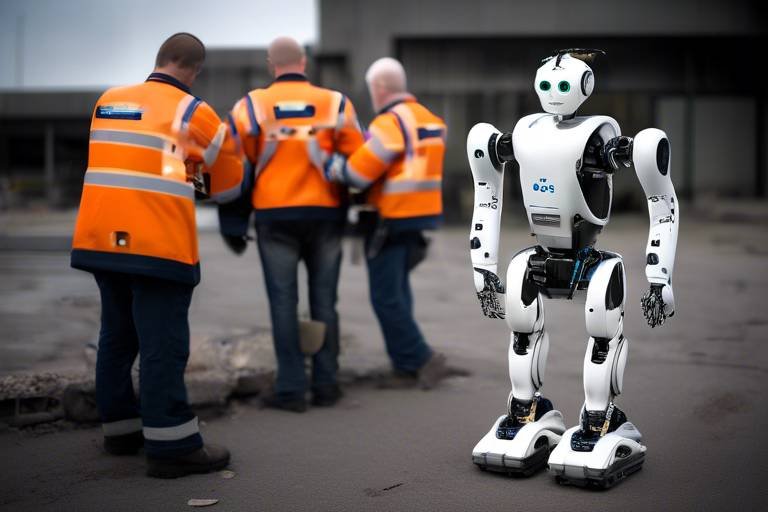The Role of AI in Enhancing E-Learning Platforms
In today's fast-paced digital world, the integration of artificial intelligence (AI) into e-learning platforms is not just a trend; it's a revolution. Imagine a classroom where every student receives a personalized learning experience tailored to their unique needs, all thanks to intelligent algorithms that adapt in real-time. This is the future of education, where AI is transforming traditional learning paradigms into dynamic, engaging environments that cater to individual learning styles.
AI has the potential to enhance user experiences significantly, making education more accessible and effective. By analyzing vast amounts of data, AI can identify patterns in student behavior and performance, allowing for the creation of customized educational pathways. This means that whether a student is struggling with a specific topic or excelling beyond expectations, AI can adjust the learning materials accordingly. It's like having a personal tutor available 24/7, ready to provide support and resources whenever needed.
Moreover, the incorporation of AI into e-learning platforms streamlines administrative tasks, freeing up educators to focus on what they do best: teaching. Imagine a world where grading assignments, tracking progress, and managing schedules are all handled by intelligent systems. This not only reduces the workload for teachers but also ensures that students receive timely feedback and support, enhancing their overall learning experience.
As we delve deeper into the various aspects of AI's role in e-learning, we'll explore how personalized learning experiences, intelligent tutoring systems, and streamlined administrative processes work together to create a more effective and engaging online learning environment. So, buckle up as we embark on this exciting journey into the future of education!
One of the most remarkable features of AI in e-learning is its ability to create personalized learning experiences. Imagine being able to learn at your own pace, with content that adapts to your unique learning style. AI enables this by analyzing how students interact with educational materials and adjusting the content accordingly. For instance, if a student struggles with a particular concept, the system can provide additional resources, tutorials, or practice exercises tailored specifically to that topic.
This personalized approach not only enhances understanding but also boosts student confidence. When learners see that the content is designed for them, they are more likely to engage with it. It's like having a customized playlist of your favorite songs, where every track resonates with your mood and preferences. With AI, education becomes a more engaging and motivating experience, leading to improved academic performance.
Another exciting aspect of AI in e-learning is the development of intelligent tutoring systems. These systems provide real-time feedback and guidance to learners, simulating one-on-one tutoring experiences. Imagine having a knowledgeable tutor by your side, ready to help you tackle complex concepts and improve your problem-solving skills. AI-driven tutoring systems analyze student responses, offering hints and explanations that guide learners toward the correct answers.
At the heart of these intelligent tutoring systems are adaptive learning algorithms. These algorithms continuously analyze student performance data, allowing the system to modify instructional materials in real-time. For example, if a student excels in mathematics but struggles with reading comprehension, the AI can adjust the curriculum to focus more on language skills while providing advanced math challenges. This creates a more effective learning path that addresses each learner's unique strengths and weaknesses.
AI doesn't just enhance the learning experience for students; it also provides valuable insights for educators. By gathering and analyzing data on student interactions, AI equips teachers with the information they need to refine their teaching strategies. This data-driven approach allows educators to identify trends, assess the effectiveness of their methods, and make informed decisions to improve overall course effectiveness.
With AI, educators can monitor student progress in real-time, enabling timely interventions and support. Imagine a dashboard that provides instant updates on each student's performance, highlighting areas where they may need additional help. This proactive approach ensures that learners stay on track toward their goals, ultimately leading to better educational outcomes.
AI also plays a crucial role in enhancing gamification elements in e-learning platforms. By incorporating interactive challenges and rewards, AI makes learning more engaging and motivating for students. Picture an online course where students earn badges for completing modules, participate in friendly competitions, and receive instant feedback on their progress. This gamified approach promotes active participation and creates a sense of community among learners, making education not just informative but also enjoyable.
Beyond enhancing learning experiences, AI tools are revolutionizing the administrative side of education. By automating various tasks such as grading and scheduling, AI allows educators to focus more on teaching and less on paperwork. This shift improves the overall efficiency of e-learning institutions, ensuring that resources are allocated where they matter most.
Automated grading systems utilize AI algorithms to evaluate student submissions, providing quick and objective assessments. This not only saves time for educators but also ensures consistent grading standards across the board. Imagine submitting an assignment and receiving instant feedback, allowing you to learn from your mistakes and improve your understanding of the material without the long wait.
Lastly, AI-powered communication tools facilitate seamless interaction between students and instructors. By employing chatbots, forums, and personalized messaging systems, AI fosters collaboration and support. Students can ask questions, seek clarification, and receive guidance at any time, creating a more supportive learning environment.
- How does AI personalize learning experiences? AI analyzes student data to tailor educational content to individual learning styles and paces.
- What are intelligent tutoring systems? These systems provide real-time feedback and guidance, simulating one-on-one tutoring experiences.
- How does AI streamline administrative processes? AI automates tasks such as grading and scheduling, allowing educators to focus more on teaching.
- Can AI help improve student engagement? Yes, through gamification and interactive challenges, AI enhances motivation and participation.

Personalized Learning Experiences
In the realm of education, one size never fits all. Just think about it: when you were in school, did you ever feel lost in a sea of information that just didn’t resonate with you? This is where artificial intelligence (AI) steps in, revolutionizing the way we learn. AI enables e-learning platforms to craft personalized educational experiences that adapt to each student's unique learning style and pace. Imagine a classroom where every student receives tailored content that speaks directly to their needs—sounds like a dream, right?
With AI, we're moving towards a world where education is no longer a rigid structure but a fluid experience. For example, students can interact with platforms that analyze their strengths and weaknesses in real-time. This analysis allows the system to adjust the difficulty of assignments, recommend additional resources, or even suggest alternative learning methods. It's like having a personal coach guiding you through your academic journey, ensuring that no student is left behind.
Furthermore, the power of AI in creating personalized learning experiences lies in its ability to gather data from various interactions. Just picture this: every time a student clicks on a lesson, answers a quiz, or engages in a discussion forum, the AI collects valuable data. This data can reveal patterns in learning behaviors, helping educators understand what works and what doesn’t. Consequently, educators can refine their teaching strategies to better meet the needs of their students.
Here are some key features of personalized learning experiences powered by AI:
- Adaptive Learning: Content that evolves based on student performance.
- Tailored Resources: Recommendations for supplementary materials that align with individual learning paths.
- Flexible Pacing: Students can learn at their own speed, ensuring mastery of concepts before moving on.
Moreover, AI-driven platforms can provide instant feedback, which is crucial for effective learning. Imagine completing a math problem and receiving immediate insights into where you went wrong. This instant feedback loop not only helps students correct their mistakes but also boosts their confidence as they witness their progress in real-time. It’s like having a personal tutor available 24/7, ready to assist whenever you need it.
In conclusion, the integration of AI into e-learning platforms is not just a trend; it’s a fundamental shift towards a more inclusive and effective educational environment. By personalizing learning experiences, AI ensures that every student has the opportunity to thrive, making education not only more accessible but also more enjoyable. With every click, every interaction, and every lesson learned, students are empowered to take control of their educational journey like never before.

Intelligent Tutoring Systems
Imagine having a personal tutor available 24/7, ready to assist you whenever you hit a snag in your studies. This is precisely what Intelligent Tutoring Systems (ITS) bring to the table. These AI-driven platforms are revolutionizing the way students learn by providing real-time feedback and tailored guidance that mimics one-on-one tutoring experiences. They analyze a learner's performance, identify areas of struggle, and offer customized support, ensuring that no student is left behind.
One of the standout features of ITS is their ability to adapt to various learning styles. Just like how some people learn better through visuals while others prefer hands-on activities, intelligent tutoring systems can adjust their teaching methods accordingly. For instance, if a student struggles with a particular math concept, the system can provide additional resources, such as interactive simulations or video tutorials, to help them grasp the material better. This personalized approach not only boosts comprehension but also enhances motivation, as students feel more engaged in their learning journey.
At the heart of Intelligent Tutoring Systems are adaptive learning algorithms. These sophisticated algorithms analyze a wealth of data, including test scores, time spent on tasks, and even patterns in a student's interactions with the platform. By processing this information, the system can modify instructional materials and create a customized learning path for each student. This means that if a student excels in a particular area, the system can accelerate their learning by introducing more challenging content, while simultaneously providing additional support in areas where they may struggle.
Consider this analogy: think of ITS as a GPS for education. Just as a GPS recalibrates your route based on real-time traffic data, intelligent tutoring systems adjust the learning path based on a student's progress and challenges. This dynamic approach helps to maximize learning outcomes and ensures that students remain on track toward achieving their academic goals.
Another remarkable benefit of ITS is their ability to provide data-driven insights to educators. By collecting and analyzing data on student interactions, these systems offer valuable feedback that can refine teaching strategies. For example, if a significant number of students struggle with a specific topic, educators can identify this trend and adjust their lesson plans accordingly. This not only enhances the overall effectiveness of courses but also fosters a more responsive learning environment.
With the integration of AI in intelligent tutoring systems, educators can monitor student progress in real-time. This capability allows for timely interventions and support, ensuring that learners stay on track toward their goals. Imagine a scenario where a student is falling behind in a critical subject. With real-time analytics, educators can quickly identify the issue and provide the necessary assistance, whether through additional resources, one-on-one support, or tailored assignments. This proactive approach can make all the difference in a student's academic journey.
In summary, Intelligent Tutoring Systems are reshaping the educational landscape by providing personalized, adaptive, and data-driven learning experiences. They not only enhance student engagement and comprehension but also empower educators with the insights needed to refine their teaching methods. As technology continues to evolve, the potential for ITS to further transform e-learning environments is limitless.
- What are Intelligent Tutoring Systems?
Intelligent Tutoring Systems are AI-driven platforms that provide personalized learning experiences, offering real-time feedback and guidance to students.
- How do adaptive learning algorithms work?
These algorithms analyze student performance data to tailor instructional materials, creating a customized learning path based on individual strengths and weaknesses.
- Can Intelligent Tutoring Systems help all students?
Yes! ITS are designed to cater to various learning styles and paces, ensuring that every student receives the support they need to succeed.
- How do educators benefit from using ITS?
Educators gain valuable insights into student performance, enabling them to refine their teaching strategies and provide timely interventions when necessary.

Adaptive Learning Algorithms
Adaptive learning algorithms are at the forefront of revolutionizing the educational landscape by providing a customized learning experience tailored to each student’s unique needs. Imagine walking into a classroom where the curriculum adjusts itself based on your strengths and weaknesses—sounds like something out of a sci-fi movie, right? But this is precisely what AI-driven adaptive learning systems offer. They analyze a learner's interactions and performance data, allowing the educational content to evolve in real-time, ensuring that every student can progress at their own pace.
These algorithms work by collecting data from various sources, such as quizzes, assignments, and even participation in discussions. For instance, if a student struggles with a specific math concept, the system can automatically provide additional resources, such as videos or practice problems, to help reinforce that topic. This personalized approach not only boosts comprehension but also keeps students engaged, as they are not forced to move on until they are ready.
The beauty of adaptive learning lies in its ability to create a dynamic educational environment. By utilizing machine learning techniques, these algorithms can predict future performance based on past behaviors. This predictive capability allows educators to identify students who may need extra support before they even realize it themselves. In essence, adaptive learning algorithms serve as a safety net, catching students before they fall behind.
To further illustrate how these algorithms function, consider the following table that outlines the key components and benefits of adaptive learning systems:
| Component | Benefit |
|---|---|
| Data Collection | Gathers insights on student performance and engagement. |
| Real-Time Adjustments | Modifies learning paths based on individual progress. |
| Personalized Resources | Offers tailored content to address specific learning gaps. |
| Predictive Analytics | Identifies students at risk of falling behind. |
In conclusion, adaptive learning algorithms are not just a trend; they are a transformative force in education. By harnessing the power of AI, these systems create a more inclusive and effective learning environment where every student can thrive. As we continue to embrace technology in education, the potential for these algorithms to enhance the learning experience is boundless. So, whether you’re a student or an educator, it’s time to get excited about the future of personalized learning!
- What are adaptive learning algorithms?
Adaptive learning algorithms are AI-driven systems that adjust educational content based on individual student performance and learning styles. - How do these algorithms improve learning?
They provide personalized resources and real-time adjustments to ensure that students receive the support they need to succeed. - Can adaptive learning systems predict student performance?
Yes, they utilize predictive analytics to identify students who may need additional help before they struggle. - Are adaptive learning algorithms suitable for all subjects?
While they are particularly effective in subjects like math and science, adaptive learning can be applied across various disciplines.

Data-Driven Insights
In the realm of e-learning, have become a game-changer, transforming the way educators approach teaching and learning. With the help of artificial intelligence, platforms can collect a wealth of data on student interactions, engagement levels, and performance metrics. This information is invaluable, as it allows educators to identify trends and patterns that might otherwise go unnoticed. Imagine having a magnifying glass that reveals the hidden strengths and weaknesses of each student—this is precisely what AI provides.
When educators harness these insights, they can tailor their teaching strategies to meet the specific needs of their students. For instance, if data shows that a significant number of learners struggle with a particular concept, instructors can pivot their approach, providing additional resources or alternative explanations. This not only enhances the learning experience but also fosters a sense of community, as students feel supported in their educational journey.
Moreover, AI can segment data into categories, allowing for a more nuanced understanding of student behavior. Consider the following types of insights that can be gathered:
- Engagement Rates: How often students log in and interact with course materials.
- Assessment Performance: Which areas students excel in and where they face challenges.
- Time Spent on Tasks: Insights into how long learners take to complete assignments, which can indicate their mastery of the subject.
This kind of detailed analysis empowers educators to make informed decisions. For example, if a teacher notices that students are spending excessive time on a specific module, it may indicate that the material is too complex or not engaging enough. Armed with this knowledge, they can adjust the curriculum to enhance clarity and interest.
Additionally, the ability to track progress in real-time means that interventions can occur promptly. If a student is falling behind, educators can reach out with support before the gap widens. This proactive approach is essential in maintaining student motivation and ensuring that no one gets left behind.
Ultimately, the integration of data-driven insights into e-learning platforms not only enriches the educational experience but also cultivates a culture of continuous improvement. As educators refine their strategies based on solid evidence, students benefit from a more responsive and engaging learning environment that truly caters to their individual needs.
- How does AI collect data on student performance?
AI collects data through various interactions within the e-learning platform, including quiz scores, time spent on tasks, and participation in discussions. - Can AI insights help in identifying at-risk students?
Yes, by analyzing engagement and performance metrics, AI can highlight students who may need additional support, allowing educators to intervene early. - What types of changes can educators make based on data insights?
Educators can adjust instructional materials, modify teaching strategies, and provide targeted resources to address specific learning challenges.

Real-Time Progress Tracking
This article explores how artificial intelligence is transforming e-learning, improving user experiences, personalizing education, and streamlining administrative tasks to create more effective and engaging online learning environments.
AI enables tailored educational content that adapts to individual learning styles and paces, ensuring that each student receives the support they need to succeed in their academic journey.
These AI-driven systems provide real-time feedback and guidance to learners, simulating one-on-one tutoring experiences that help students grasp complex concepts and improve their problem-solving skills.
Adaptive learning algorithms analyze student performance data to modify instructional materials, creating a more effective learning path that addresses each learner's unique strengths and weaknesses.
AI gathers and analyzes data on student interactions, providing educators with valuable insights to refine teaching strategies and enhance overall course effectiveness.
Imagine being able to see exactly how your students are doing at any given moment. powered by AI makes this possible, enabling educators to monitor student engagement and comprehension as lessons unfold. This immediate feedback loop is crucial because it allows instructors to identify struggling students before they fall too far behind. Think of it as having a GPS for education, guiding students on their journey and ensuring they stay on the right path.
With AI systems in place, educators can receive alerts when a student is lagging in their assignments or not participating in discussions. This proactive approach means that interventions can be made swiftly, whether through personalized messages, additional resources, or one-on-one support. The ability to track progress in real-time not only helps students but also allows teachers to adjust their methods based on what is working and what isn’t.
Furthermore, real-time tracking can enhance the learning experience by providing students with instant feedback on their performance. For instance, if a student submits an assignment, they can immediately see their scores and comments, helping them understand their mistakes and learn from them. This immediacy fosters a growth mindset, encouraging students to embrace challenges and persist through difficulties.
Here’s how real-time progress tracking can be beneficial:
- Immediate Feedback: Helps students understand their learning gaps instantly.
- Targeted Interventions: Allows educators to offer support tailored to individual needs.
- Enhanced Engagement: Keeps students motivated by showing them their progress.
- Data-Driven Decisions: Empowers educators to refine their teaching strategies based on real-time data.
In summary, real-time progress tracking is a game-changer in the e-learning landscape. It not only supports students in their learning journey but also equips educators with the tools they need to create a more dynamic and responsive learning environment.
AI enhances gamification elements in e-learning platforms, making learning more engaging and motivating for students through interactive challenges and rewards that promote active participation.
AI tools automate various administrative tasks, such as grading and scheduling, allowing educators to focus more on teaching and less on paperwork, ultimately improving the overall efficiency of e-learning institutions.
These systems utilize AI algorithms to evaluate student submissions, providing quick and objective assessments that save time for educators while ensuring consistent grading standards.
AI-powered communication tools facilitate seamless interaction between students and instructors, fostering collaboration and support through chatbots, forums, and personalized messaging systems.
- What is AI in e-learning? AI in e-learning refers to the use of artificial intelligence technologies to enhance educational experiences through personalized learning, real-time feedback, and data analysis.
- How does AI personalize learning? AI personalizes learning by analyzing individual student data and adapting content to fit their unique learning styles and paces.
- Can AI replace teachers? While AI can assist in many educational tasks, it is intended to complement teachers, not replace them. The human touch in education remains irreplaceable.
- What are the benefits of real-time progress tracking? Real-time progress tracking allows for immediate feedback, targeted interventions, enhanced student engagement, and data-driven teaching strategies.

Gamification and Engagement
In the world of e-learning, gamification has emerged as a powerful tool to boost student engagement and motivation. Imagine walking into a classroom where learning feels less like a chore and more like an adventure. That's the magic of gamification! By incorporating game-like elements into educational platforms, AI is transforming the way students interact with content. This approach not only makes learning enjoyable but also encourages students to actively participate in their educational journey.
So, what exactly does gamification entail? It involves integrating features such as points, badges, and leaderboards into e-learning systems. These elements serve as incentives, pushing students to complete tasks, participate in discussions, and achieve learning milestones. For instance, when a student completes a module, they might earn points that contribute to a leaderboard, fostering a sense of competition and achievement. This friendly rivalry can be a fantastic motivator, driving students to engage more deeply with the material.
Moreover, AI enhances gamification by personalizing the learning experience. Imagine a student who struggles with a certain topic; AI can analyze their performance and adapt the challenges accordingly. This means that instead of feeling overwhelmed, the student receives tailored tasks that are just the right level of difficulty. It’s like having a personal coach who knows exactly when to push you and when to ease off, making the learning process both effective and enjoyable.
Another exciting aspect of gamification is the use of interactive challenges. These challenges can take various forms, such as quizzes, puzzles, or even simulations. They not only reinforce the material but also allow students to apply what they've learned in a fun and engaging way. For example, a science course might include a simulation where students can conduct virtual experiments. This hands-on approach helps solidify concepts in a way that traditional learning methods may not.
Furthermore, the element of rewards plays a crucial role in maintaining student motivation. When students achieve certain milestones, they can unlock rewards that can be used within the platform—think of it as leveling up in a video game. This creates a sense of accomplishment and encourages continued participation. The psychological impact of receiving rewards can’t be underestimated; it taps into intrinsic motivation, making students feel valued and recognized for their efforts.
In conclusion, the integration of gamification in e-learning platforms, powered by AI, creates an engaging and dynamic learning environment. By transforming traditional educational experiences into interactive adventures, students are more likely to stay motivated and committed to their studies. As we look to the future of education, it’s clear that gamification will continue to play a pivotal role in enhancing student engagement and fostering a love for learning.
- What is gamification in e-learning? Gamification involves adding game-like elements to educational content to enhance engagement and motivation.
- How does AI contribute to gamification? AI personalizes the learning experience by adapting challenges to individual student needs and tracking progress.
- What are some examples of gamification elements? Examples include points, badges, leaderboards, interactive challenges, and rewards.
- Why is gamification effective in education? It makes learning fun, encourages active participation, and provides a sense of achievement through rewards and competition.

Streamlined Administrative Processes
In the fast-paced world of education, especially in the realm of e-learning, administrative tasks can often feel like a heavy weight dragging down the entire learning experience. Fortunately, artificial intelligence is stepping in to lighten this load. By automating various administrative processes, AI allows educators to focus more on what truly matters: teaching and engaging with their students. Imagine a world where grading assignments, scheduling classes, and managing student records are as easy as clicking a button. Sounds like a dream, right? Well, that dream is becoming a reality!
One of the most significant advancements in this area is the introduction of automated grading systems. These AI-driven tools can evaluate student submissions with remarkable speed and accuracy. Instead of spending countless hours poring over papers, educators can leverage AI algorithms to provide quick assessments. This not only saves time but also ensures that grading standards remain consistent across the board. Picture this: a teacher who used to spend an entire weekend grading papers can now use that time to develop engaging lessons or provide one-on-one support to students who need it the most.
Moreover, AI enhances communication within e-learning environments. With the help of AI-powered communication tools, interaction between students and instructors becomes seamless. Chatbots can answer common questions instantly, forums can be moderated intelligently, and personalized messaging systems can ensure that every student feels connected and supported. This level of interaction fosters a collaborative atmosphere where students are more likely to seek help and engage actively with their coursework.
To give you a clearer picture, here’s a table that summarizes some of the key benefits of AI in streamlining administrative processes:
| Administrative Task | AI Application | Benefits |
|---|---|---|
| Grading | Automated Grading Systems | Quick, objective assessments; consistent grading standards |
| Scheduling | AI Scheduling Tools | Efficient class scheduling; reduced conflicts |
| Communication | AI-Powered Chatbots | Instant responses; enhanced student-instructor interaction |
| Data Management | AI Analytics Tools | Streamlined record-keeping; valuable insights for educators |
As we dive deeper into the world of e-learning, it's essential to recognize that these streamlined processes not only improve efficiency but also enhance the overall learning experience. With AI handling the administrative burden, educators can devote more time to fostering creativity, critical thinking, and collaboration among students. This shift not only benefits teachers but also empowers students to take charge of their learning journeys.
In conclusion, the integration of AI into administrative processes is a game-changer for e-learning platforms. It’s like having a personal assistant who never tires and is always ready to help. The future of education is bright, and with AI leading the charge, we can expect a more engaging, efficient, and effective learning environment for everyone involved.
- How does AI improve grading in e-learning?
AI automates the grading process, providing quick and objective assessments, which saves educators time and ensures consistent standards. - What types of communication tools does AI provide?
AI offers chatbots, personalized messaging systems, and forums that enhance interaction between students and instructors. - Can AI help with scheduling classes?
Yes, AI scheduling tools can efficiently manage class schedules and reduce conflicts, ensuring a smoother educational experience. - What are the benefits of data management through AI?
AI analytics tools streamline record-keeping and provide valuable insights that help educators refine their teaching strategies.

Automated Grading Systems
In the fast-paced world of e-learning, are revolutionizing how educators assess student performance. Imagine a world where teachers can focus more on engaging with their students rather than drowning in piles of assignments waiting to be graded. Sounds like a dream, right? Well, thanks to artificial intelligence, this dream is becoming a reality. These systems utilize sophisticated AI algorithms to evaluate student submissions efficiently and effectively, ensuring that assessments are both quick and objective.
One of the most significant advantages of automated grading systems is their speed. Traditional grading can take days, or even weeks, especially in large classes. However, AI-driven systems can provide instant feedback, allowing students to understand their mistakes and learn from them immediately. This rapid feedback loop not only keeps students engaged but also helps them to improve continuously. Just think about it: when students receive timely responses, they are more likely to stay motivated and on track with their learning goals.
Moreover, these systems maintain consistent grading standards. Human graders can be influenced by various factors—fatigue, bias, or even mood—leading to inconsistencies in how assignments are evaluated. In contrast, AI grading systems apply the same criteria across the board, ensuring that every student is assessed fairly. This level of objectivity is crucial in maintaining the integrity of educational assessments and can significantly reduce disputes over grades.
Let’s break down how these systems work. Typically, they rely on a combination of natural language processing and machine learning techniques to analyze student submissions. For example, when a student submits an essay, the AI evaluates it based on various parameters, such as grammar, coherence, and adherence to the prompt. The system can even provide constructive feedback, offering suggestions for improvement, which is something that traditional grading often lacks.
However, it’s essential to understand that automated grading systems are not without their challenges. While they excel at grading objective assignments, such as multiple-choice questions, they can struggle with more subjective tasks, like open-ended essays. Therefore, many educational institutions have adopted a hybrid approach, using AI for initial grading and human educators for final assessments. This combination ensures that students benefit from the efficiency of AI while still receiving the nuanced feedback that only a human can provide.
As we look to the future, the role of automated grading systems in e-learning will undoubtedly expand. With ongoing advancements in AI technology, we can expect these systems to become even more sophisticated, capable of understanding context and providing deeper insights into student performance. The ultimate goal is to create a more personalized learning experience where educators can dedicate their time to nurturing students’ potential rather than being bogged down by administrative tasks.
In summary, automated grading systems are not just a technological trend; they are a vital component of the modern educational landscape. By embracing these innovations, educational institutions can enhance the learning experience, ensuring that students receive the timely feedback they need to succeed while allowing educators to focus on what they do best—teaching.
- What is an automated grading system?
An automated grading system is an AI-powered tool that evaluates student submissions, providing quick and objective assessments. - How does automated grading improve learning?
By offering instant feedback, it helps students identify mistakes and learn from them immediately, keeping them motivated. - Are automated grading systems completely reliable?
While they are efficient, it's best to use them in conjunction with human evaluators for subjective assignments to ensure fairness. - What types of assignments are best suited for automated grading?
Objective tasks, such as multiple-choice questions and quizzes, are ideal for automated grading systems.

Enhanced Communication Tools
This article explores how artificial intelligence is transforming e-learning, improving user experiences, personalizing education, and streamlining administrative tasks to create more effective and engaging online learning environments.
AI enables tailored educational content that adapts to individual learning styles and paces, ensuring that each student receives the support they need to succeed in their academic journey.
These AI-driven systems provide real-time feedback and guidance to learners, simulating one-on-one tutoring experiences that help students grasp complex concepts and improve their problem-solving skills.
Adaptive learning algorithms analyze student performance data to modify instructional materials, creating a more effective learning path that addresses each learner's unique strengths and weaknesses.
AI gathers and analyzes data on student interactions, providing educators with valuable insights to refine teaching strategies and enhance overall course effectiveness.
With AI, educators can monitor student progress in real-time, allowing for timely interventions and support to keep learners on track toward their goals.
AI enhances gamification elements in e-learning platforms, making learning more engaging and motivating for students through interactive challenges and rewards that promote active participation.
AI tools automate various administrative tasks, such as grading and scheduling, allowing educators to focus more on teaching and less on paperwork, ultimately improving the overall efficiency of e-learning institutions.
These systems utilize AI algorithms to evaluate student submissions, providing quick and objective assessments that save time for educators while ensuring consistent grading standards.
In the realm of e-learning, effective communication is crucial for fostering a collaborative learning environment. AI-powered communication tools are revolutionizing how students and instructors interact, bridging the gap that often exists in online education. Imagine having a personal assistant that is always available to answer questions, provide resources, and facilitate discussions. That's precisely what these tools offer!
One of the standout features of AI-enhanced communication is the use of chatbots. These intelligent bots can respond to student inquiries 24/7, providing instant answers to frequently asked questions. Whether a student is struggling with a specific concept or needs clarification on assignment deadlines, chatbots can deliver timely support, ensuring that no learner feels left behind.
Moreover, AI tools can analyze communication patterns and preferences, allowing for personalized messaging systems. For instance, if a student tends to engage more through video calls rather than text, the system can prioritize video conferencing options for that individual. This adaptability ensures that communication is not only effective but also comfortable for the user.
Additionally, these tools can facilitate forums and discussion boards where students can collaborate on projects or share insights. Imagine a virtual classroom where students can freely exchange ideas, much like they would in a physical setting. AI can help moderate these discussions, ensuring that all voices are heard and guiding conversations toward productive outcomes.
In summary, AI-enhanced communication tools are not just about making things easier; they are about creating a vibrant learning community where students and instructors can thrive together. The integration of these technologies is paving the way for a more connected and interactive educational experience.
- How does AI personalize learning experiences?
AI analyzes individual student performance and preferences to tailor educational content, ensuring that each learner receives support that matches their unique needs. - What are intelligent tutoring systems?
These are AI-driven platforms that provide real-time feedback and guidance, mimicking the personalized attention of a one-on-one tutor. - How can AI streamline administrative tasks?
AI automates tasks like grading and scheduling, allowing educators to concentrate on teaching rather than paperwork. - What role do chatbots play in e-learning?
Chatbots provide instant support to students, answering questions and facilitating communication between learners and instructors.
Frequently Asked Questions
- How does AI personalize learning experiences?
AI personalizes learning by analyzing individual student data, such as their learning pace and style. This allows e-learning platforms to tailor educational content specifically to each learner's needs, ensuring a more effective and engaging experience.
- What are intelligent tutoring systems?
Intelligent tutoring systems are AI-driven platforms that provide real-time feedback and guidance to students. They simulate a one-on-one tutoring experience, helping learners to understand complex concepts and improve their problem-solving skills.
- How do adaptive learning algorithms work?
Adaptive learning algorithms continuously assess student performance and adjust instructional materials accordingly. This creates a customized learning path that caters to each student's unique strengths and weaknesses, making learning more effective.
- What kind of data does AI analyze for educational insights?
AI analyzes various data, including student interactions, performance metrics, and engagement levels. This data helps educators gain valuable insights into teaching strategies and course effectiveness, allowing them to make informed adjustments.
- Can educators track student progress in real-time?
Yes! AI enables real-time progress tracking, allowing educators to monitor student performance continuously. This capability lets teachers provide timely interventions and support, ensuring students stay on track to meet their learning goals.
- How does AI enhance engagement through gamification?
AI enhances gamification by integrating interactive challenges and rewards into e-learning platforms. This approach makes learning more engaging and motivating, encouraging students to actively participate in their educational journey.
- What administrative tasks can AI automate?
AI can automate various administrative tasks, such as grading assignments and managing schedules. By streamlining these processes, educators can focus more on teaching and less on paperwork, improving overall efficiency in e-learning institutions.
- How do automated grading systems work?
Automated grading systems use AI algorithms to evaluate student submissions. They provide quick and objective assessments, saving educators time while maintaining consistent grading standards across the board.
- What are AI-powered communication tools?
AI-powered communication tools facilitate seamless interactions between students and instructors. These tools include chatbots, forums, and personalized messaging systems, fostering collaboration and support in the learning environment.



















